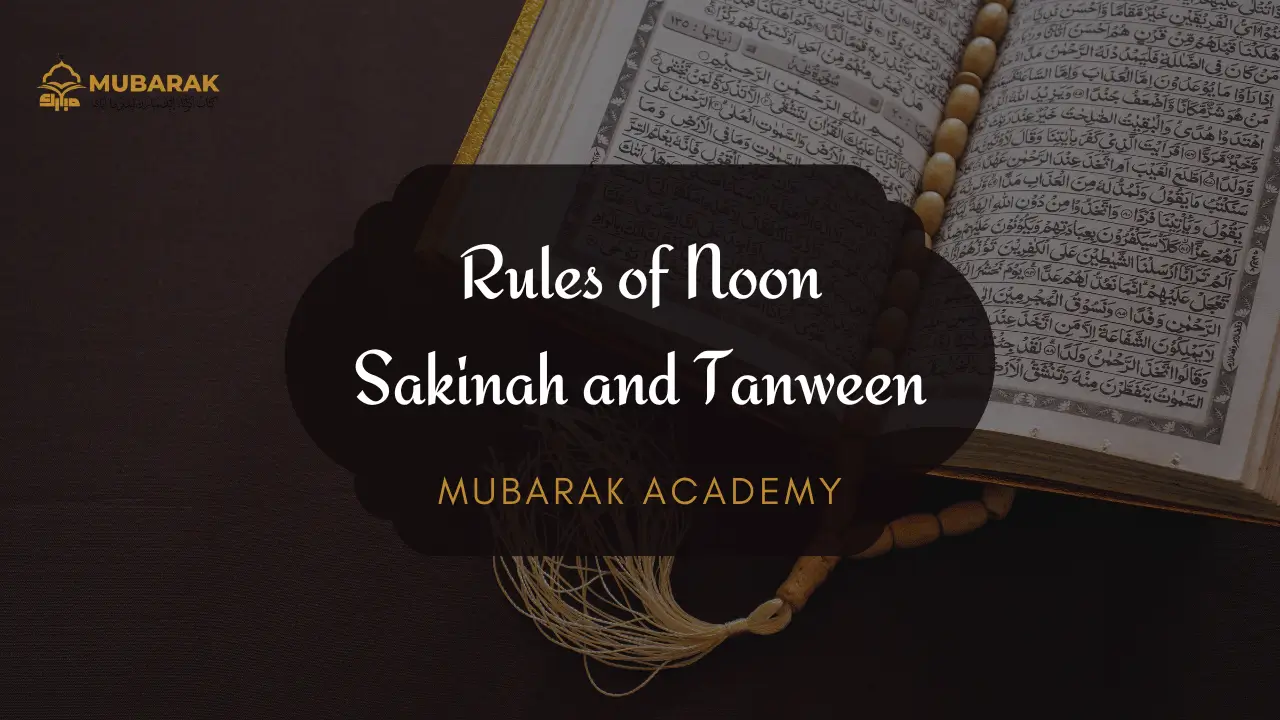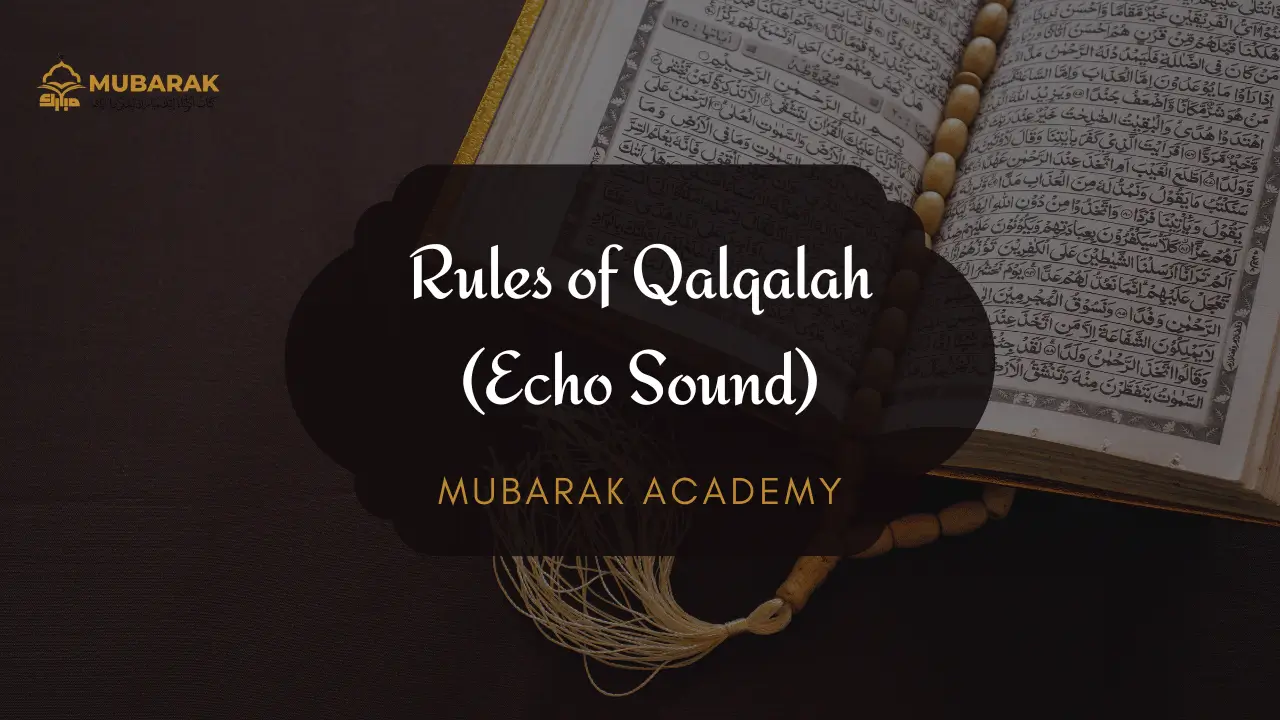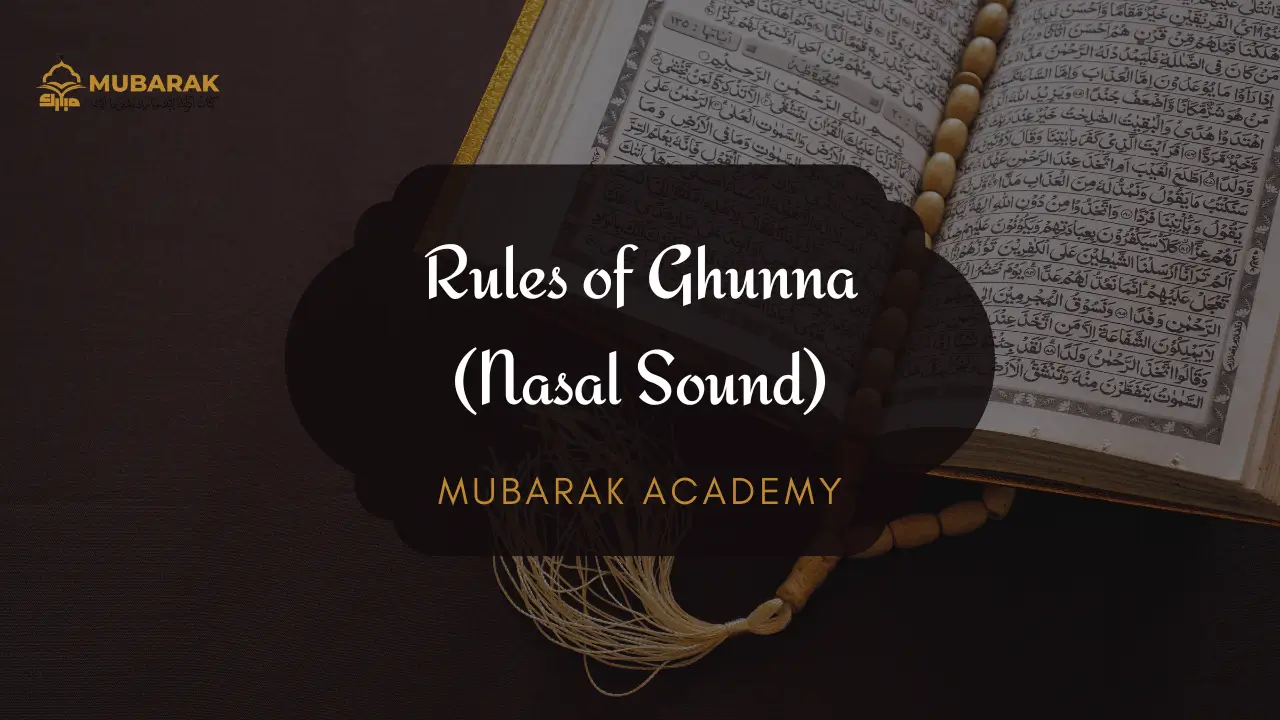Tajweed aims to perfect and beautify your recitation of the holy Quran. Learning the Tajweed rules with examples is an essential step in your journey with the Quran that helps you recite them exactly as our Prophet Muhammad ﷺ. In this blog, you will get a concise yet quick guide to basic rules of Tajweed in English, its types, and examples to clear up and simplify your grasp of it.
Main Types of Tajweed Rules with Examples
Tajweed requires learning through listening and practice more than just theatrical study to match the appropriate recitation. Showing Tajweed rules with examples in the following lines is just to put you at the beginning of the way, telling you the roadmap you will follow in your journey. The Tajweed rules are:
- Noon Saakinah and Tanween
- Meem Saakinah
- Al-Madd
- Qalqalah
- Tarqeeq and Tafkheem
- Noon and Meem Mushaddad
- Waqf and Ibtida
- Ghunnah
- Sifaat-al-Huroof
- Makharij-al-Huroof
These rules are guidelines for reading the Quran with correct pronunciation and intonation, ensuring the precise delivery of each letter and sound. Most importantly, reciting the holy Quran correctly maintains the authenticity of the Quranic text as it was revealed on our Prophet Muhammad ﷺ. They cover various aspects from the characteristics of letters to when to start and stop in your reading.
1. Rules of Noon Sakinah and Tanween

Regularly, teachers start with this lesson as it’s simple and needed while reciting, taking into consideration that a reciter comes across this rule frequently. This Tajweed rule is related to the vowels and letters that create the ‘nnn‘ sound, which are Noon Sakinah and Tanween, “a double vowel that adds the noon sound.” Let’s dive into the first rule of Tajweed rules with examples and see the types of Noon Sakinah and Tanween rules:
1. Idhaar الإظهار
The simpliest type of Noon Sakinah and Tanween rule. If noon sakinah or a tanween is followed by these 6 letters:
(ء ه ع ح غ خ) — the Noon sound must be pronounced clearly
For Example:
- منْ حادّ
- منْ خير
2. Idghaam الإدغام
Idghaam is merging Noon Sakinah or Tanween sound with the following letter. It occurs when Noon Sakinah or Tanween is followed by one of these letters:
(ي، ر، م، ل، و، ن)
For instance: مِن نَّـفْعِهِمَا
It is two types:
- With Ghunnah: If the following letter is one of these letters [ي ن م و], apply ghunnah with the following letter.
- Without Ghunnah: If the following letter [ل ر], just merge noon sound and it without ghunnah.
3. Iqlaab الإقلاب
It means in Arabic (to convert), noon sakinah or tanween is converted into a meem [م] when followed by a baa [ب].
For instance: مِن بَعْدِ is read like مِم بَعْدِ.
4. Ikhfaa الإخفاء
Ikhfaa means hiding, which applies to the remaining letters that not mentioned in the previous types:
( ت ث ج د ذ س ش ص ض ط ظ ف ق ك )
A noon sakinah or tanween is hidden with apply ghunnah, when it’s followed by one of the above letters.
Read more About: Rules of Noon Sakinah and Tanween
2. Rules of Meem Sakinah

Meem Sakinah is as simple and crucial as Noon Sakinah and Tanween rule. It typically has three rules:
1. Al-Ikhfaa الإِخْفَاء الشَّفَوِي
It occurs with only one letter and that is Baa (ب). If a Baa comes after Meem Sakinah at the end of a word, you must apply Al-Ikhfaa with Ghunna.
For instance: ربهم بهم
2. Al-Idghaam Al-Mithlayn الإِدْغَام المِثْلَين
When a Meem Sakinah at the end of a word is followed by also a Meem Mutaharrik at the beginning of the next word, you should merge them together as one meem with Ghunna.
For instance: قلوبهم مرض
3. Al-Ithhar Ashafawi الإِظْهَار الشَّفَوِي
All the letters, except Baa and Meem, are the letters of Ithhar.
For instance: دِينُكُمْ وَلِيَ
3. Rules of Madd (Elongation)

Madd (المد) means elongation of the sound of one of the three letters of Madd, which are:
ا ي و
It is divided into two types:
1. Madd Asli:
It occurs when a Madd letter is not followed by a hamzah or a letter with a sukun, taking two counts/Harakat.
For instance: قال – يقول – قيل
2. Madd Firi:
It occurs when a madd letter is followed with a Hamzah, or a letter with a sukun, dividing into several types that you can learn in detail by reading What is Madd in Tajweed
Discover Also: What is Madd in Tajweed, Its Types and Rules
4. Rules of Qalqalah (Echo Sound)

Qalqalah is simply the echoing sound that happens when a letter of Qalqalah letters comes with, whether it’s in the middle of a word or at the end. Qalqalah letters are: ق ط ب ج د
Combined in the sentence;قُطْبُ جَدٍ
For instance: وَالْفَجْرِ / أَحدْ
Taking into consideration, if you stop on the letter of Qalqalah that comes at the end of a word, it’s pronounced with a medium echoing sound.
Plus, if the Qalqalah letter has a Shaddah, it’s pronounced with a stronger echo. Qalqalah is one of the most important Tajweed rules with examples that help you recite the holy Quran accurately and beautifully.
5. Rules of Ghunna (Nasal Sound)

Ghunna is a sound produced from the nasal passage, this unconditional nasalized sound fixed on the letter noon ن, whether it is a tanween or meem. Once we pronounce the letters م and ن in specific conditions, such as Idghaam الإدغام or Ikhfaa الإخفاء, ghunna goes into the nose making its distinct sound. In Ghunna, we must hold the sound in our nose for 2 counts/ Harakat. Mastering this rule is an important step in your way towards fluency in reciting the holy Quran, which helps you to beautify your recitation and facilitates the rest of Tajweed rules with examples
For instance:
“عَمَّ يَتَسَاءَلُون”
“فَمَن يَعْمَلْ مِثْقَالَ ذَرَّةٍ خَيْرَاً يَرَه”
“كَلَّا إِنَّهَا تَذْكِرَة”
6. Tafkheem and Tarqeeq (Heavy and Light Letters)
Tafkheem and Tarqeeq rule is a crucial rule that is related to the letters characteristics and ensuring the proper pronunciation, relating to the heaviness or lightness of a letter’s sound. Basically, this rule determines how full or thin the sound of a letter should be while reciting the holy Quran. Tafkheem requires the mouth echoes or reverberates to produce the right sound of heavy letters. Therefore, when you come across one of these letters: خ ص ض غ ط ق ظ
That are collected in the sentence: خص ضغط قظ
Your tongue should be raised, leaving a space between the floor of the mouth and the roof of the mouth (the soft palate) to make it possible for the heaviness that will happen. On the other hand, Tarqeeq is lightning on saying a letter sound, making the letter soft and clear. You can produce it by keeping your tongue in a relaxed position in the mouth.
The Tarqeeq letters are the rest of the letters not mentioned in the Tafkheem letters.
7. Waqf and Ibtida’ (Stopping and Starting)

Among the many Tajweed rules with examples that are mentioned in this blog, this rule is the most needed as many individuals are not aware of the rules of Waqf and Ibtida’. However, such rules have a great impact on the meaning of the Quranic text, enhancing the clarity and understanding of it.
Waqf Conditions
- Maintaining the verse’s meaning is the main Waqf condition that avoids any miscommunications or incorrect readings of the words of the Quran.
- Clear pronunciation that enables the listener to understand the message.
- Understanding the purpose of every pause by a good grasp of the verses’ context.
- Delivering the message to the listener to understand that a new concept is being presented.
Ibtida’s Conditions
- The recitation starting must be consistent with the previous Waqf to make sure that the meaning is maintained.
- Pronouncing the new phrase’s first letter correctly to maintain the recitation’s rhythm and flow.
- It’s essential to be aware of the context and the new verse’s relationship to the following one.
8. Ghunnah in Tajweed
Ghunnah is one of the most popular rules in Tajweed that distinguishes your reciting of the holy Quran. It is the sound that is produced out of the nasal cavity, specifically when articulating the letters Noon نون and Meem ميم. Making this sound depends on opening the nostril. Here it is how to apply this rule fluently:
Ghunna in Quranic recitation is applied when certain sakin letters, like Noon (ن) or Meem (م), are followed by specific sounds that need nasalization. For instance, what we mentioned above of Idghaam and Ikhfaa rules. It helps with better and clearer pronunciation and smoother recitation.
The main function of Ghunnah is to maintain the flow of the verses. It’s important to have good understanding and application of Ghunna rules to keep the beauty of recitation and ensure your tone aligns with the meanings of the Quran.
9. Sifaat-al-Huroof in Tajweed
Sifaat-al-Huroof, which means characteristics, is the way that an Arabic letter’s sound is produced to distinguish each letter from another. Learning Sifaat-al-Huroof in Tajweed ensures articulate recitation of the holy Quran as it clears up the differences between letters and their sounds, which can be confusing for non-native speakers. In addition, it enhances the clarity of your recitation.
Sifaat-al-Huroof are categorized into:
1. Sifaat al-Lazimah:
Which are inherent to the letter that can never be changed.
2. Sifaat al-‘Aaridah:
Which are temporary and have been added to a letter only in specific cases, like the rules of Tafkheem and Tarqeeq or Madd.
10. Makharij-al-Huroof in Tajweed
Makharij-al-Huroof means the point of emitting the letter while pronouncing. Each letter in the Arabic language has a place it can be produced from, they are divided into these five categories that are mentioned below. Every Makhraij of them is responsible for a group of letters. Learning more about Makharij-al-Huroof plays a crucial role in pronouncing properly without much effort.
The five ultimate Makharij are:
- Al-Jawf
- Al-Halq
- Al-Lisaan
- Ash-Shafataan
- Al-Khayshoom
Learn Also: What is Makhraj in Tajweed?
Importance of Learning Tajweed
Learning Tajweed rules with examples is not only to beautify the recitation, but it also ensures the message is not distorted by mistake because reciting without applying the Tajweed rules correctly can change the whole meaning of words.
- This change may occur due to just mispronouncing the elongations or stopping points that can alter the meaning. For instance; in the verse “ إِنَّ اللَّهَ لَا يَسْتَحْيِي أَن يَضْرِبَ مَثَلًا مَّا بَعُوضَةً فَمَا فَوْقَهَا ۚ فَأَمَّا الَّذِينَ آمَنُوا فَيَعْلَمُونَ أَنَّهُ الْحَقُّ مِن رَّبِّهِمْ ۖ وَأَمَّا الَّذِينَ كَفَرُوا فَيَقُولُونَ مَاذَا أَرَادَ اللَّهُ بِهَٰذَا مَثَلًا ۘ يُضِلُّ بِهِ كَثِيرًا وَيَهْدِي بِهِ كَثِيرًا ۚ وَمَا يُضِلُّ بِهِ إِلَّا الْفَاسِقِينَ” of Surah Al-Baqarah that you should be aware of it’s Haram to stop at the word يَسْتَحْيِي as it changes the meaning and makes you fall into a big mistake.
- There are multiple benefits of reading the Quran properly, applying the Tajweed rules. our Prophet Muhammad ﷺ said: “One who recites the Quran beautifully, smoothly, and precisely will be in the company of noble angels. As for the one who recites it with difficulty, stammering or stumbling through its verses, (s)he will have twice that reward.” [Al-Bukhari]
Learn Tajweed with Mubarak Academy
Learning Tajweed requires practice, it is difficult to hear your own mistakes during reciting, so reciting to a proficient teacher can help you a lot. Mubarak Academy is a reliable Online Quran academy, which offers you the best courses that are well-structured with professional teachers that help students learn efficiently ensuring an engaging and meaningful learning process.
Recommended Courses:
- Quran Memorization Course
- Tajweed Quran Online Course
- Islamic Studies Course
- Arabic Language Course
- Quran Ijazah Course
Conclusion
By following the Tajweed rules with examples, reciters honor the sacredness of the Quran and grasp its message effectively. For such a reason you should start now learning the Quran with Tajweed to get unlimited rewards and taste the beauty of the holy Quran.
Learn Tajweed Quran Online Now!
Frequently Asked Questions
1. What is Ghunnah?
It’s a nasal sound that comes out of your nose when pronouncing specific letters.
2. What is the Sakin letter?
Sakin refers to a letter with sukoon. In other words a letter that is not a vowel.
3. How long does it take to learn Tajweed rules with examples?
It depends on your program and the time of practicing. Overall, at least a year to master it and be able to recite the Quran perfectly.
4. Can I learn Tajweed on my own?
If you are good at self-study, it can be achievable. Apps and videos can help. However, it’s not as accurate as learning with a teacher.
5. Is Tajweed mandatory?
Scholars ensure that applying the Tajweed rules to avoid changing the meaning is obligatory.




